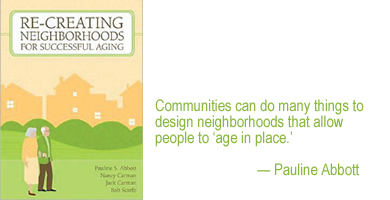Re-Creating Neighborhoods
Making communities accessible for older residents
March 3, 2008
By Valerie Orleans
Designing neighborhoods that work for the young and the old ensures the health of individuals and communities alike.
As baby boomers grow older, city planners, developers and boomers themselves are starting to assess ways to make neighborhoods more accessible and welcoming for those who are growing older. Pauline Abbott, director of Cal State Fullerton’s Institute for Gerontology, recently co-edited a forthcoming book, “Re-creating Neighborhoods for Successful Aging,” that draws from the fields of gerontology, health sciences, community planning, landscape architecture and environmental design to explore ways to make communities safer and more friendly to populations that are growing older.

“There are many things that communities can do when they’re designing neighborhoods that allow people to ‘age in place,’” she said. “That may mean things like making doorways wider in homes so that wheelchairs — and strollers — can easily pass through them.
“We also encourage builders, when designing homes, to make sure that at least one bedroom and bathroom are on the first floor,” she continued. “We usually see two-story homes with all the bedrooms upstairs. Navigating stairs can be difficult for seniors and small children. That’s why we recommend that at least one bedroom is located on the ground floor. And no sunken living rooms or rooms on different levels.”
Recently, Abbott, two architects and a group of senior citizens met with a group of gerontology students and faculty to review plans for a city park. The students discovered that sometimes function trumps style.
“The students had designed a brick pathway through the park,” Abbott said. “It looked lovely, but the seniors pointed out that bricks make it very difficult for walkers to move smoothly. Also, bricks can become uneven over time, making walking more precarious.”
Such simple solutions as re-thinking walkways can make a huge difference in how easily older citizens can navigate through neighborhoods.
“Actually, some of the changes we’re recommending are based on old city planning models similar to small European villages,” Abbott said. “Because land is at a premium in much of Europe, you see a blend of retail, businesses and homes all built near one another. It’s not unusual to have shops or businesses on a first floor and housing on upper floors. When you’re older, having services such as grocery stores, banks, libraries, post offices and shops nearby are a great help. Since many seniors don’t drive — or prefer not to drive — they need services within walking distance.”
There’s another benefit, as well, to integrating commerce and residential building. Walking is great exercise for seniors — the corner bakery becomes a place to socialize, as do neighborhood shops.
“Several studies indicate that the farther you drive to work, the more likely you are to gain weight,” said Abbott. “Creating neighborhoods where you can walk to work helps the environment and your health, and builds a sense of community.”
Many architects are convinced that these “old world” principles are he key to creating supportive neighborhoods.
Another option is a senior community, like Morningside in Fullerton, that offers aging boomers an option to maintain an active lifestyle with access to healthcare and home health services as they become necessary, social activities and programs that many senior citizens enjoy.
“Some enjoy living in age-segregated communities,” Abbott said. “But we also find many who would prefer to live independently in their own homes. For that reason, we need to consider how we are building and developing neighborhoods.”
What also tends to happen is that residents who have lived in their homes and community for decades develop them into what are referred to as “naturally occurring retirement communities” (NORCs).
“While the senior communities are wonderful, we also need to make sure that we’re addressing the needs of those in NORCs,” Abbott said. “In order to do that, planners need to consider the availability of healthcare services, religious establishments and areas where seniors can gather to socialize.”
Abbott is currently working with the city of Brea on their senior citizens’ advisory commission to ensure that Brea is a “user-friendly” city.
“At some point, we’re all going to have to face the fact that we’re growing older,” Abbott said. “By designing neighborhoods that work for both young and old families, we ensure the health not only of individuals but also of our communities.”


